Triumph TR6
The Triumph TR6 (1968–76) is a sports car built by British Triumph Motor Company between 1969 and 1976. The TR6 was introduced in January 1969 and was produced through July 1976. The first series have commission numbers commencing with CP or CC. CP designating petrol injection and CC designating carburettors for the US market. The first bodies were built at Liverpool, in September 1968 and by December 1968 1,468 USA spec TR6s had been assembled at Canley, along with 51 export-market TR6PIs, home UK market assembly did not begin until the first few days of January 1969. The PI model has a brake horse power of 150, whereas for the US model, it is 104 bhp. The TR6 was the best-seller of the TR range when production ended, a record subsequently surpassed by the TR7. Of the 91,850 TR6s produced, 83,480 were exported; only 8,370 were sold in the UK.[4]
| Triumph TR6 | |
|---|---|
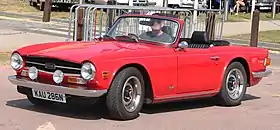 | |
| Overview | |
| Manufacturer | Triumph Motor Company |
| Production | 1968–1976 |
| Assembly | Coventry, England |
| Body and chassis | |
| Class | Roadster |
| Body style | 2 door convertible |
| Layout | FR layout |
| Powertrain | |
| Engine | 2.5-litre straight-6 |
| Transmission | 4-speed manual[1] all synchromesh[2] with optional overdrive[3] |
| Dimensions | |
| Wheelbase | 2,235 mm (88.0 in)[1] |
| Length | 3,950 mm (155.5 in)[1] |
| Width | 1,550 mm (61.0 in)[1] |
| Height | 1,270 mm (50.0 in)[1] |
| Kerb weight | 1,130 kg (2,491 lb)[1] |
| Chronology | |
| Predecessor | Triumph TR5 TR250 (United States and Canada) |
| Successor | Triumph TR7 |
The frame, engine, running gear, body tub and doors were similar to the Michelotti-styled TR5[5] (TR250 in the US). The front and rear of the car was restyled by Karmann of Germany, though one source claims the new squared-off Kamm tail design was from an unrelated Michelotti prototype. A new removable hardtop was designed in-house.[6]
Unofficial Mark I and Mark II variants
It is important to note that the limited run of early 1969 cars are slightly different to the 1970-onwards car. The 1969 model (unofficially a MKI) only 704 Right Hand Drive cars produced for the Home Market can be readily identified by having steel wheels with Rostyle “tin-plate” wheel trim covers, a body coloured windscreen surround, a body coloured short trim bead located from the top of the boot deck towards the end of the doors, a steering wheel with dished black spokes and non-reclining horse shoe shaped seats, two piece side indicator lenses and tiger striped radiator hoses. The early 1969/MKI Right Hand Drive (G plate) cars are now extremely rare and potentially only a handful exist in original form and have become the desirable car and the most collectable.
The US models a total of 7,981 Left Hand Drive cars were produced in 1969 and all had high backed seats, wire wheels with red marked tyres and are all LHD. A number of modifications were introduced for the 1970 model (MKII) including a matt black windscreen surround, painted steel wheels with a chrome surround and black centre trim, reclining seats and a non dished grey spoked steering wheel.
Features
All TR6s were powered by Triumph's 2.5-litre straight-6, with the same Lucas mechanical fuel-injection as the TR5 for the United Kingdom and global markets, and carburetted for the United States, as had been the US-only TR250. The TR6PI (petrol-injection) system helped the home-market TR6 produce 150 bhp (110 kW) (152 hp DIN) at model introduction.
The TR6 featured a four-speed manual transmission. An optional electrically switched overdrive operated on second, third, and fourth gears on early models and third and fourth on later ones. Construction was traditional frame. Other features included semi-trailing arm independent rear suspension, rack and pinion steering, 15-inch (380 mm) wheels and Michelin asymmetric XAS tyres which dramatically improved the handling, pile carpet on floors and trunk/boot, bucket seats, and full instrumentation. Brakes were discs at the front and drums at the rear. A factory steel hardtop was optional, requiring two people to deploy. The dashboard was walnut veneer. Other factory options included a rear anti-roll bar and a limited-slip differential.
The UK version TR6PI could accelerate from zero to 60 mph (97 km/h) in 8.2 seconds and had a top speed of 120 mph (190 km/h) according to Autocar magazine.[7]
As of 2020, approximately 4000 licensed for use and 1300 temporarily stored SORN TR6s were registered with the DVLA in the UK.[8]
Gallery
- Triumph TR6 Gallery
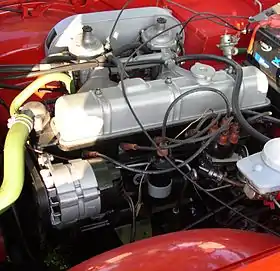 The 2.5-l inline 6 engine of a carbureted TR6
The 2.5-l inline 6 engine of a carbureted TR6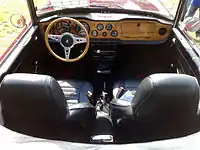 TR6 left-hand drive interior
TR6 left-hand drive interior TR6 side view
TR6 side view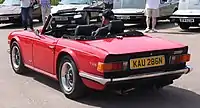 TR6 rear quarter view
TR6 rear quarter view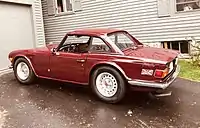 TR6 with optional removable hardtop
TR6 with optional removable hardtop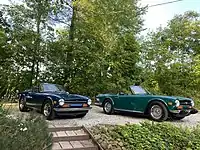 1972 and 1974 TR6
1972 and 1974 TR6
References
- "1969 Triumph TR6". carfolio.com. Retrieved 1 January 2008.
- "Autotest: Triumph TR6 PI". Autocar. 130. Vol. (nbr3818). 17 April 1969. pp. 2–6.
- "British Motor Heritage Limited". Retrieved 18 February 2015.
- vtr.org. "A History of the TR6". Archived from the original on 30 November 2010. Retrieved 11 October 2010.
- "Autotest: Triumph TR6 PI". Autocar. 130. No. nbr3818. 17 April 1969. pp. 2–6.
…so Karmann Ghia were consulted for a quick rejuvenating process, and the result is a kind of smoothed out TR with fashionable and effective use of matte black for the radiator grill and undercut tail panel
- Taylor, James (1997). Triumph TR. Osecola, WI 54020, USA: Motorworks International Publishers & Wholesalers. p. 89. ISBN 0-7603-0407-6.CS1 maint: location (link)
- Autocar, full road test 1969
- "How Many Left web site". howmanyleft.co.uk. Retrieved 17 July 2011.
| Wikimedia Commons has media related to Triumph TR6. |